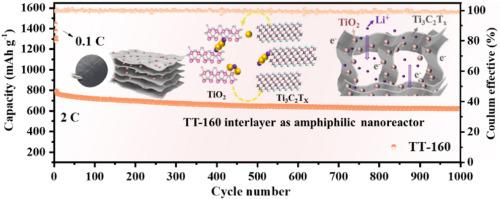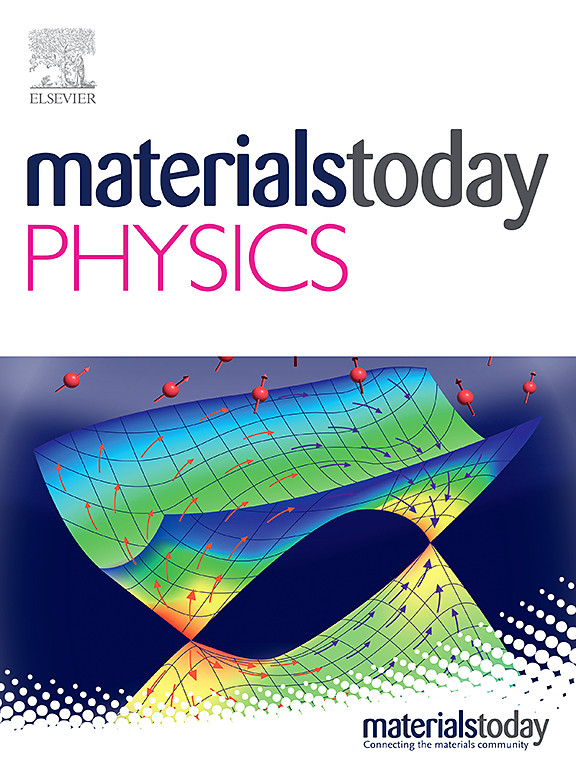通过微波辅助水热法构建 TiO2-Ti3C2Tx 异质结,作为高性能锂硫电池的两性纳米反应器
IF 10
2区 材料科学
Q1 MATERIALS SCIENCE, MULTIDISCIPLINARY
引用次数: 0
摘要
由于众所周知的锂多硫化物(LiPSs)穿梭效应和缓慢的电化学反应动力学,锂硫(Li-S)电池的应用面临着巨大障碍。为了解决这些问题,具有独特层状结构和金属中心的 MXene 已成为锂-S 电池中很有前景的添加剂,它通过物理和化学限制机制有效地阻碍了多硫化物的迁移。然而,MXenes 本身缺乏锂多硫化物的稳固锚定位点,导致循环稳定性不理想。本文通过微波辅助水热法(MAH)构建了源自 MXene 的 TiO2-Ti3C2Tx(TT)异质结。这种创新的 TT 复合材料结合了一种两亲性纳米反应器,可协同吸附、催化锂离子电池并稳定锂离子电池中的锂阳极。在 TT 结构中,Ti3C2Tx 的最佳暴露表面和纳米尺寸的 TiO2 可协同 "传导、吸附和转化 "锂离子,而异质界面和皱褶片则为电解液中的 Li+ 提供了有效的三维传输途径,从而共同提高了锂离子电池的稳定性。因此,TT-160 作为锂-S 电池的中间膜,在 2 C 条件下循环 1000 次后,每次循环的容量衰减仅为 0.022%,具有超低的容量衰减。此外,导电中间膜促进了 Li+ 传输的均匀分布,使得使用 TT-160 组装的锂/锂对称电池在 1000 小时内具有出色的稳定性。这项工作开创性地证明了通过 MAH 合成的 MXene 衍生 TiO2-Ti3C2Tx 异质结在高性能锂-S 电池方面的潜力,为材料设计和优化开辟了新的途径。本文章由计算机程序翻译,如有差异,请以英文原文为准。


Building TiO2-Ti3C2Tx heterojunction by microwave-assisted hydrothermal as an amphiphilic nanoreactor for high-performance lithium sulfur batteries
The adoption of lithium-sulfur (Li-S) batteries faces significant obstacles due to the notorious lithium polysulfides (LiPSs) shuttle effect and sluggish electrochemical reaction kinetics. To tackle these issues, MXene, with the unique layered structures and metal centers, have emerged as promising additives in Li-S batteries, effectively hindering the migration of polysulfides through physical and chemical confinement mechanisms. However, MXenes inherently lack robust anchoring sites for LiPSs, leading to suboptimal cycle stability. Here, TiO2-Ti3C2Tx (TT) heterojunction derived from MXene is constructed by the microwave-assisted hydrothermal (MAH). This innovative TT composite incorporates an amphiphilic nanoreactor that synergistically adsorbs, catalyzes LiPSs, and stabilizes the lithium anode in Li-S batteries. The optimally exposed surface of Ti3C2Tx and nano-sized TiO2 within the TT architecture collaborate to “conduct, adsorb and transform” LiPSs, while the heterogeneous interface and crumpled sheets provide an efficient three-dimensional transport pathway for Li+ in the electrolyte, collaboratively enhancing the stability of Li-S batteries. Therefore, the TT-160 as an interlayer for Li-S battery exhibits an ultra-low capacity attenuation of each cycle of 0.022 % after 1000 cycles at 2 C. Furthermore, the conductive interlayer facilitates a uniform distribution of Li+ transport, enabling a Li//Li symmetric cell assembled with TT-160 to achieve remarkable stability over 1000 h. This work pioneeringly demonstrates the potential of MXene-derived TiO2-Ti3C2Tx heterojunction, synthesized via MAH for high-performance Li-S batteries, opening up new avenues for material design and optimization.
求助全文
通过发布文献求助,成功后即可免费获取论文全文。
去求助
来源期刊

Materials Today Physics
Materials Science-General Materials Science
CiteScore
14.00
自引率
7.80%
发文量
284
审稿时长
15 days
期刊介绍:
Materials Today Physics is a multi-disciplinary journal focused on the physics of materials, encompassing both the physical properties and materials synthesis. Operating at the interface of physics and materials science, this journal covers one of the largest and most dynamic fields within physical science. The forefront research in materials physics is driving advancements in new materials, uncovering new physics, and fostering novel applications at an unprecedented pace.
 求助内容:
求助内容: 应助结果提醒方式:
应助结果提醒方式:


